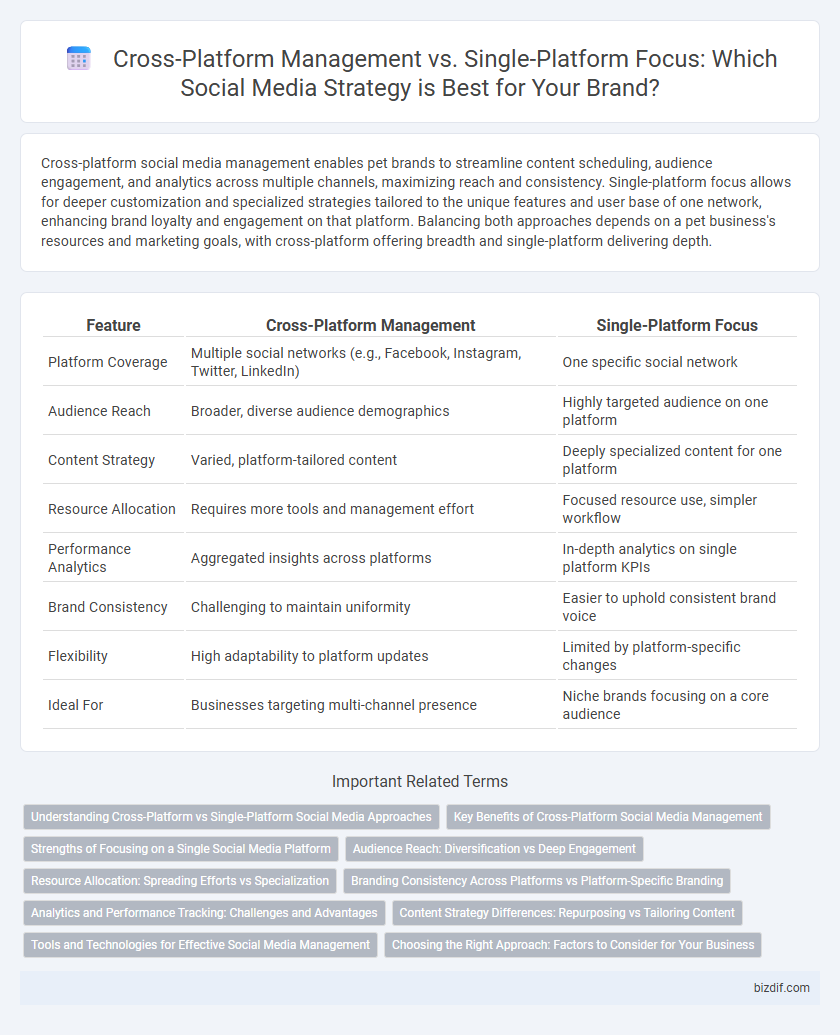Cross-platform social media management enables pet brands to streamline content scheduling, audience engagement, and analytics across multiple channels, maximizing reach and consistency. Single-platform focus allows for deeper customization and specialized strategies tailored to the unique features and user base of one network, enhancing brand loyalty and engagement on that platform. Balancing both approaches depends on a pet business's resources and marketing goals, with cross-platform offering breadth and single-platform delivering depth.
Table of Comparison
| Feature | Cross-Platform Management | Single-Platform Focus |
|---|---|---|
| Platform Coverage | Multiple social networks (e.g., Facebook, Instagram, Twitter, LinkedIn) | One specific social network |
| Audience Reach | Broader, diverse audience demographics | Highly targeted audience on one platform |
| Content Strategy | Varied, platform-tailored content | Deeply specialized content for one platform |
| Resource Allocation | Requires more tools and management effort | Focused resource use, simpler workflow |
| Performance Analytics | Aggregated insights across platforms | In-depth analytics on single platform KPIs |
| Brand Consistency | Challenging to maintain uniformity | Easier to uphold consistent brand voice |
| Flexibility | High adaptability to platform updates | Limited by platform-specific changes |
| Ideal For | Businesses targeting multi-channel presence | Niche brands focusing on a core audience |
Understanding Cross-Platform vs Single-Platform Social Media Approaches
Cross-platform social media management enables brands to maintain a consistent voice and broaden audience reach by scheduling content across multiple networks like Instagram, Facebook, and Twitter simultaneously. Single-platform focus allows deeper engagement and tailored content strategies optimized for the unique algorithms and user behaviors of one specific site, such as LinkedIn for B2B marketing. Understanding the trade-offs between cross-platform scalability and single-platform specialization is crucial for maximizing social media ROI and audience growth.
Key Benefits of Cross-Platform Social Media Management
Cross-platform social media management enhances brand visibility by coordinating consistent messaging across multiple channels, increasing audience reach and engagement. It streamlines content scheduling and analytics monitoring through centralized tools, saving time and improving strategic decision-making. Managing diverse platforms collectively also enables better audience insights and adaptive marketing strategies tailored to varied user behaviors.
Strengths of Focusing on a Single Social Media Platform
Focusing on a single social media platform allows brands to deeply understand its unique algorithms, audience behaviors, and content formats, optimizing engagement and growth more effectively. This concentrated approach fosters stronger community building and brand loyalty through tailored interactions and consistent messaging. Specialized expertise in one platform also streamlines resource allocation, resulting in higher quality content and improved campaign performance.
Audience Reach: Diversification vs Deep Engagement
Cross-platform management maximizes audience reach by diversifying content distribution across multiple social media channels, capturing varied demographic segments and increasing brand visibility. Single-platform focus fosters deep engagement through tailored content and community-building strategies, enhancing audience loyalty and interaction within a specific social network. Balancing these approaches depends on marketing goals, with cross-platform strategies driving breadth and single-platform efforts enabling depth in audience relationships.
Resource Allocation: Spreading Efforts vs Specialization
Allocating resources in social media management requires balancing cross-platform efforts with single-platform specialization, where spreading efforts across multiple channels can diversify audience reach but may dilute content quality. Concentrating resources on a single platform allows deeper engagement and tailored strategies, enhancing brand presence and ROI. Effective budget distribution and team skills must align with business goals to optimize content creation, scheduling, and analytics across chosen platforms.
Branding Consistency Across Platforms vs Platform-Specific Branding
Maintaining branding consistency across platforms ensures a unified brand identity, fostering stronger recognition and trust among audiences. Cross-platform management enables synchronized messaging and cohesive visual elements, while platform-specific branding tailors content to unique audience behaviors and platform features. Balancing these strategies enhances brand visibility and engagement by combining consistency with adaptability.
Analytics and Performance Tracking: Challenges and Advantages
Cross-platform social media management offers comprehensive analytics by aggregating data across multiple platforms, enabling a holistic view of performance and audience behavior. Single-platform focus provides deeper insights with platform-specific metrics and advanced tools tailored to one network, allowing for more precise optimization. Challenges in cross-platform tracking include data inconsistency and integration complexity, while single-platform management limits reach but simplifies performance analysis.
Content Strategy Differences: Repurposing vs Tailoring Content
Cross-platform management demands repurposing content to maintain consistent messaging across diverse social channels, optimizing reach and engagement by adjusting formats without altering core themes. Single-platform focus emphasizes tailoring content specifically to the unique audience behaviors and algorithms of that platform, driving deeper connections through highly customized posts. Effective social media strategies balance repurposing efficiency with platform-specific tailoring to maximize impact and audience resonance.
Tools and Technologies for Effective Social Media Management
Cross-platform management utilizes integrated tools like Hootsuite and Buffer to schedule, analyze, and optimize content across multiple social media platforms, enhancing efficiency and brand consistency. Single-platform focus often relies on native analytics and platform-specific tools such as Facebook Business Suite or Twitter Analytics, allowing for deeper, tailored engagement and strategy development. Leveraging AI-driven technologies and automation features supports real-time monitoring and data-driven decision-making, maximizing social media performance across diverse channels.
Choosing the Right Approach: Factors to Consider for Your Business
Evaluating cross-platform management versus a single-platform focus depends on your business goals, target audience, and resource availability. Cross-platform strategies enhance brand visibility and engagement by reaching diverse demographics, while single-platform focus allows for deeper, more tailored content optimization and community building. Assess platform analytics, content creation capabilities, and ROI expectations to determine the most effective social media management approach for your business growth.
Cross-platform management vs Single-platform focus Infographic

 bizdif.com
bizdif.com